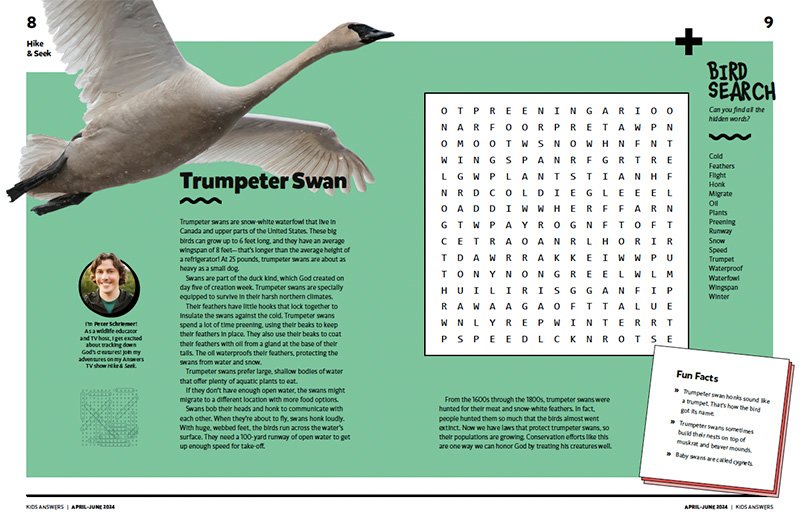Trumpeter Swan
Hike & Seek
by Peter Schriemer on April 1, 2024Trumpeter swans are snow-white waterfowl that live in Canada and upper parts of the United States.
These big birds can grow up to 6 feet long, and they have an average wingspan of 8 feet—that’s longer than the average height of a refrigerator! At 25 pounds, trumpeter swans are about as heavy as a small dog.
Fun Facts
- Trumpeter swan honks sound like a trumpet. That’s how the bird got its name.
- Trumpeter swans sometimes build their nests on top of muskrat and beaver mounds.
- Baby swans are called cygnets.
Swans are part of the duck kind, which God created on day five of creation week. Trumpeter swans are specially equipped to survive in their harsh northern climates.
Their feathers have little hooks that lock together to insulate the swans against the cold. Trumpeter swans spend a lot of time preening, using their beaks to keep their feathers in place. They also use their beaks to coat their feathers with oil from a gland at the base of their tails. The oil waterproofs their feathers, protecting the swans from water and snow.
Trumpeter swans prefer large, shallow bodies of water that offer plenty of aquatic plants to eat.
If they don’t have enough open water, the swans might migrate to a different location with more food options.
Swans bob their heads and honk to communicate with each other. When they’re about to fly, swans honk loudly. With huge, webbed feet, the birds run across the water’s surface. They need a 100-yard runway of open water to get up enough speed for take-off.
From the 1600s through the 1800s, trumpeter swans were hunted for their meat and snow-white feathers. In fact, people hunted them so much that the birds almost went extinct. Now we have laws that protect trumpeter swans, so their populations are growing. Conservation efforts like this are one way we can honor God by treating his creatures well.
Bird Search
Can you find all the hidden words?
- Cold
- Feathers
- Flight
- Honk
- Migrate
- Oil
- Plants
- Preening
- Runway
- Snow
- Speed
- Trumpet
- Waterproof
- Waterfowl
- Wingspan
- Winter

I’m Peter Schriemer! As a wildlife educator and TV host, I get excited about tracking down God’s creatures! Join my adventures on my Answers TV show Hike & Seek.
Kids Answers Magazine
What If Disaster Strikes?
When disasters like volcanoes and tornadoes strike, what can we learn to protect our communities in the future?
Browse Kids Issue- © 2024 Answers in Genesis
- Privacy Policy
- Contact
- About


